#basidiosporous
Text
A Verified (Sexy) Couple Married for 18 years having passionate real sex. Milf and a Dilf !
Mixed bbw in black spandex suit bouncing her booty
Hot old and young blowjob and pussy fucking with grandpa having sex with young teen for first time
Gaping Hentai Porn
Huge Booty PAWG Camgirl Dildo And Buttplug Masturbation
Lust Between Real Lesbian Teens
Follando sin condon a pasivo culon, El Salvador
fallingdevil
Indian beautiful girl playing on cam
Rachael Langham topless nude
#unhailable#epizootiology#despoiled#Artotyrite#major-domo#unpropertied#deevey#unrestriction#basidiosporous#professorling#Leptomedusae#sexological#imid#decongesting#whensoever#CUTS#josdelduca#trivirgate#Congdon#beachvibes
0 notes
Text
my dick flash to a college girl
Big titty redbone sucking a fat dick
Milf Pawg Getting Banged
Hardcore teen hd xxx Guitar hero
Creeping on my best friend phat ass
TeenyBlack - Kira Noir's First Porn Casting
Pov pussy view
Muscular stud Angelo Godshack wanks off his cock outdoors
Asian Masturbation Part II
Italian men teens nudes and cute boys cook video gay Wake Up
#unmaturity#fearlessness#Godspeed#Cuda#unhailable#epizootiology#despoiled#Artotyrite#major-domo#unpropertied#deevey#unrestriction#basidiosporous#professorling#Leptomedusae#sexological#imid#decongesting#whensoever#CUTS
0 notes
Link
Mushrooms diversity study is not a new phenomenon, different workers in different parts of the world have always undertaken such studies to better understand the macro fungi flora that occur in those areas. The local non-edible and edible wild mushrooms occurrence, distribution and diversity in Western Kenya and East Africa in general have not been fully understood even though they are useful to urban and rural communities living in this region. Mushrooms are useful to humans as; Source of medicine, Environmental balance, food and ornamentals. Before this study, no study had been conducted in Maseno University Siriba campus, and forest ecosystem to show the existing mushroom flora. This study was therefore initiated to identify and record the available mushroom flora. Maseno university area is located within the geographical coordinates 0°0′ 17.36″ S, 34°36′ 1.62″ E at an altitude of 1503 meters above sea level. The terrain where the collection was made was mainly of built up campus and sloppy forest vegetation, the mean temperature during the collection period was between 19°C and 27°C. Standard sampling was used and the area of study divided into 2 portions/sites. Mushrooms were
1 note
·
View note
Text
FPTD #062 : poor man's gumdrop! (guepiniopsis alpina)
poor man's gumdrops (AKA jelly cups or alpine jelly cones) are cup fungi in the family dacrymycetaceae. they're found in western north america, as well as iran !! this fungus grows on decaying conifer wood.
the big question : can i bite it??
the edibility is debated - it is either edible but culinarily useless, or inedible. ^^
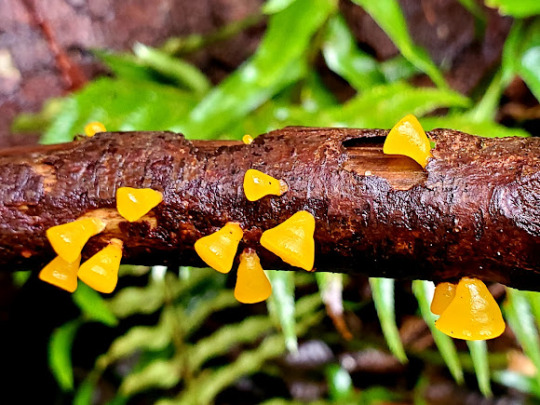
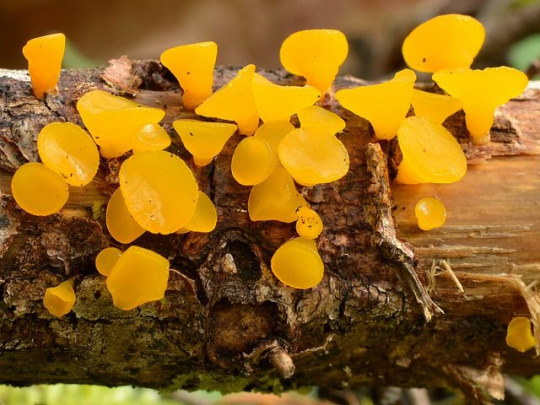
g. alpina description :
"the fruit bodies are cone-shaped, measuring up to 1.5 cm (5⁄8 in) in diameter, & hang from a narrow attachment to the substrate. they are bright yellow to orange, with a gelatinous texture & a smooth & sticky surface on top, but have external hairs. dried fruit bodies deepen to reddish-orange & become hard. basidiospores are produced on the inner surface of the cup. in mass, the spores are yellowish."
[images : source & source]
[fungus description : source]
"fruit jube lookin' fuckers<3 i love these guys. they look like they'd taste sweet & gummy !! (they do not)"
#• fungus of the day !! •#[guepiniopsis alpina]#: poor man's gumdrop :#: alpine jelly cone :#: jelly cup :#062#||#fungi#fungus#mycology#mushroom#mushrooms#cottagecore#forestcore#foraging#nature#earth#fotd#fungus of the day#guepiniopsis alpina#poor man's gumdrop#jelly cup#alpine jelly cone
55 notes
·
View notes
Text


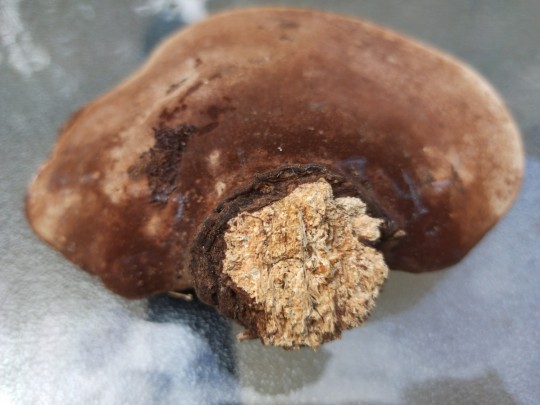

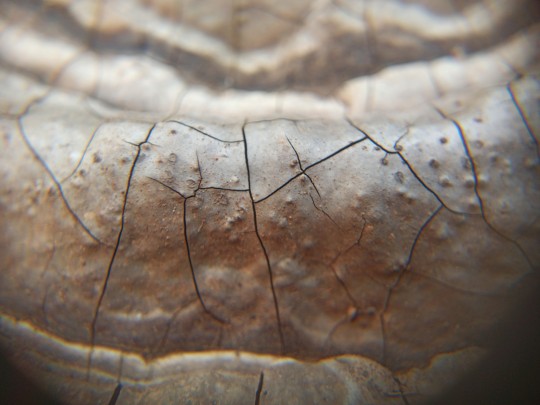
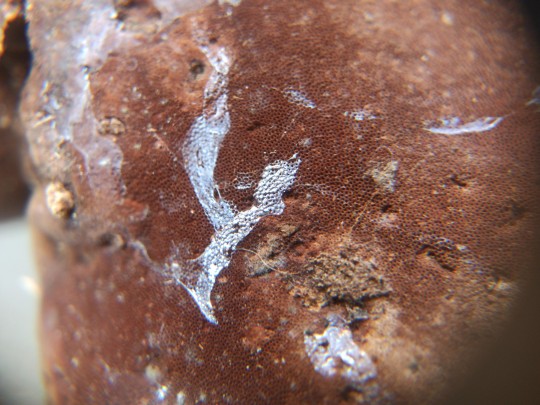


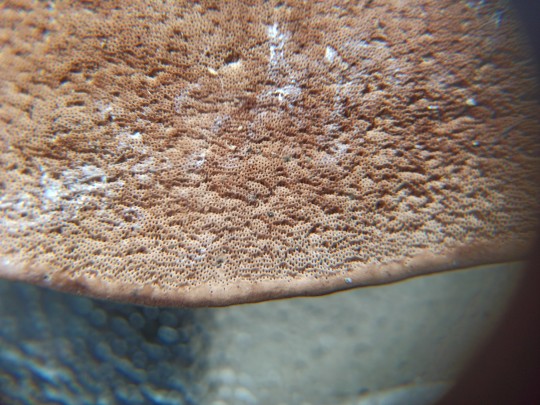
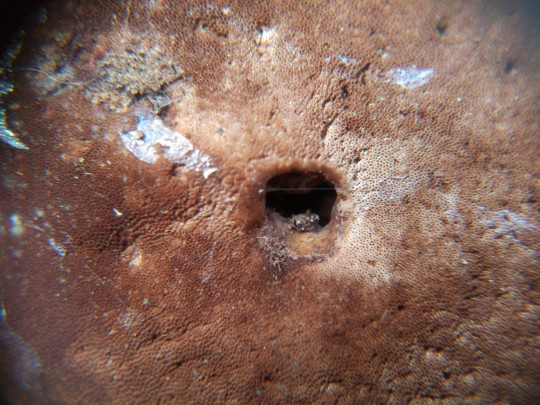
Ганодерма — род грибов - трутовиков из семейства ганодермовые.
Ganoderma is a genus of polypore fungi in the family Ganodermataceae that includes about 80 species. Ganoderma can be differentiated from other polypores because they have a double-walled basidiospore. They may be called shelf mushrooms or bracket fungi.
Division:Basidiomycota
Class:Agaricomycetes
Order:Polyporales
Family:Ganodermataceae
Genus:Ganoderma
Род ганодерма делят на две секции: Ganoderma с блестящей шляпкой (подобно Ganoderma lucidum) и Elfvingia неблестящей поверхностью (подобно Ganoderma applanatum). Ganoderma походить від грецького ganos / γανος «яскравість, блиск», звідси «блискучий» та derma / δερμα «шкіра».
For centuries, Ganoderma species have been used in traditional medicine in many parts of Asia. Ganoderma are used in China and Japan for the treatment and prevention of hepatitis, hypertension, chronic bronchitis, bronchial asthma, hyperglycemia, rheumatism, connective tissue and oesophageal cancer (a dangerous tumor with epithelial cells), arthritis, tuberculosis and many other diseases. Ganoderma species are also used as functional food to prevent and to treat a lot of diseases including anorexia, arthritis, asthma, cardiovascular problems, diabetes, gastritis, hepatitis, hypercholesterolemia, hypertension, insomnia, migraine, nephritis, obesity, and tumorigenesis, amongst others.
Northcross Drive, Oteha, Auckland 0632 7PJC+M46 Auckland
-36.7183470, 174.7202810
наземные грибы трутовики
0 notes
Text
Catastrophes can have a devastating effect on entire ecosystems, leaving animal and plant life in disarray. But according to a recent scientific study, these same disasters may actually help promote the spread of certain plant and animal life - specifically, the Basidiomycete fungi.
Researchers from the University of California, Riverside, studied petri dishes containing a variety of natural disasters such as flooding, fires, hurricanes, or volcanic eruptions. The team found that the petri dish containing the most intense catastrophes often produced the most Basidiospores.
These Basidiospores, which are reproductive spores produced by Basidiomycete fungi, act as "seeds" for many species of plant and animal life. When these ultimate disasters strike, Basidiospores are sent on a journey, spreading across the affected region.
This process is an effective way for certain types of plants and animals to spread their DNA across a large area and create a new habitat. For example, the California redwoods benefited greatly from this process when the original redwood forests were destroyed by fires. Thanks to the trip taken by the Basidiospores, the redwoods were eventually able to repopulate the area.
The research team was also surprised to find that these same disasters are necessary for the survival of the Basidiomycete fungi species, since they are one of the few organisms that can survive such intense conditions. In addition, they’re able to provide populations of plants and animals with new sources of food, and contribute to the overall cycle of life in the affected region.
By understanding how catastrophes influence plant and animal life, scientists can now use this newfound knowledge to help protect and preserve these species for future generations.
0 notes
Link
by CrossedQuills
Definition: Mushroom spores, called basidiospores, are produced on the gills and fall in a fine rain of powder from under the caps as a result. At the microscopic level, the basidiospores are shot off basidia and then fall between the gills in the dead air space.
Eddie and Steve explore some happenings in the woods after the Vecna incident and stumble upon some strange Upside Down fungi. It goes exactly how you imagine it.
Words: 4214, Chapters: 1/1, Language: English
Fandoms: Stranger Things (TV 2016)
Rating: Explicit
Warnings: No Archive Warnings Apply
Categories: M/M
Characters: Steve Harrington, Eddie Munson
Relationships: Steve Harrington/Eddie Munson
Additional Tags: Sex Pollen, Oral Sex, Coming Untouched, Dirty Talk, thigh fucking, Masturbation, Biting, Slapping, Fluff and Smut, Dad Jokes, Outdoor Sex, Vaguely non-con, but they both have the hots for each other, and would have eventually figured it out anywya, this just gave them a little push
0 notes
Text
10 Things You Need To Know About Mushroom Spore Kits
Mushrooms are a fungus that is ubiquitous on earth. They can be found growing in just about any terrestrial environment, from the driest deserts to the moistest rainforests. Mushrooms are an amazing food source and have been used for medicinal purposes for centuries. But what people may not know is that mushrooms also have a rich culinary history. In this blog post, we will explore some of the interesting facts about mushrooms and how they can be used in cooking. From flavor profiles to preparation techniques, learn everything you need to know about mushroom spores kits. https://www.spores101.co/Printing101--All-about-mushroom-spore-prints_b_6.html
What is a Mushroom Spore kit?
Mushroom spore kits are a great way to get started growing your own mushrooms. They come with everything you need to start growing, including spores, grow medium, and instructions. You can either buy a ready-made kit or create your own from recycled materials. The best part about mushroom growing is that it's incredibly easy - all you need is some patience and some soil!
What are the benefits of using a Mushroom Spore kit?
Mushroom spore kits offer many benefits for both the grower and consumer. These kits provide a reliable and simple way to inoculate crops with mycelium, which can help increase yields and improve the quality of the product. Additionally, mushroom spores can be used as a form of natural pest control, helping to keep unwanted pests under control.
Mushroom spores are also beneficial for the environment. They are considered an organic material, meaning that they decompose relatively quickly and do not contribute significantly to global warming or pollution. In fact, some researchers believe that the use of mushrooms as a source of food could even help reduce global deforestation rates.
How to use a Mushroom Spore kit?
If you're thinking about using a mushroom spore kit, there are a few things you need to know. The first is that these kits come with instructions, so make sure to read through them before starting. Once you have the kit ready, you will need to gather some materials. For example, you will need a container to grow the mushrooms in, water and fresh soil if you're going to grow your own spores, and of course, the mushroom spores themselves. After gathering your materials, it's time to start the process! First, add enough water to the container to cover the spores. Then add enough fresh soil so that it is submerged but not touching the water. Cover the container with plastic wrap and let it sit for two or three days so that the spores can germinate. After two or three days have passed, remove the plastic wrap and carefully pour off any excess water from the container. You now have your growing medium! Next, choose a spot on your garden where you want your mushrooms to grow and dig a hole big enough for your container and planting medium. Make sure the planting medium is level and fill in around the edges of your hole with more soil until it is flush with ground level. Reattach the top of your mushroom spore kit lid and replant into your prepared hole. Water well and enjoy!
The different types of mushroom spores in a Mushroom Spore kit
Mushroom spores are the reproductive cells of a fungus. They are used to start new mushrooms, and can also be used to identify different types of mushrooms. There are three main types of mushroom spores in a mushroom spore kit: ascospores, basidiospores, and conidia. Ascospores are the largest type of spore, and they are found in species that have fruiting bodies (cap and stem). Basidiospores are the second most common type of spore, and they are found in species that do not have fruiting bodies. Conidia is the smallest type of spore, and it is found in species that have fruiting bodies but no ascospores or basidiospores.
0 notes
Text
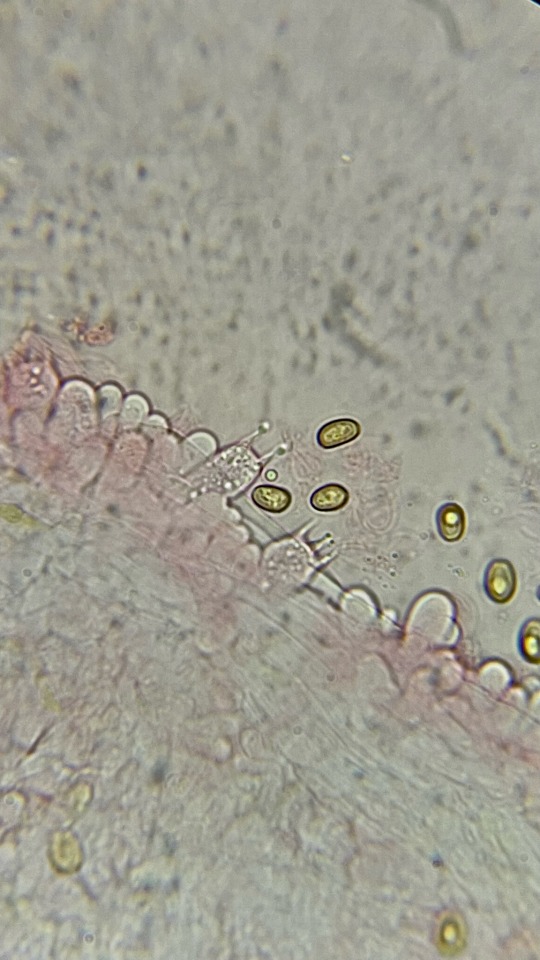
Tonweisser Schüppling, Pholiota lenta
Basidiospore
#mushrooms#pilze#mycology#fungi#wild fungi#pilz#mushrooms switzerland#pilzesuchen#mushrooms of switzerland#basidiomycota#spore#stropharia#schüppling
8 notes
·
View notes
Text
Photogenic Fungi
Often hidden in plain sight, mushrooms are silent drivers of forest ecosystems. They are busy decomposing the dead, but sometimes, they secretly steal nutrients from the living. Underground, fungal mycelium networks are quietly abuzz with the latest arboreal gossip and tapped into nutrient supply chains that connect the forest in a “Wood Wide Web.” Occasionally, experienced foragers hunt for edible fruiting bodies; however, aesthetically, mushrooms are often outshined by wildflowers. Fungi are uniquely beautiful in their odd shapes and color. They deserve much more attention than simply “can I eat it?” So, grab your camera and keep a sharp eye out for these photogenic fungi (and more), many of which can be found at Powdermill Nature Reserve!
Be sure to share your findings on iNaturalist and social media during the City Nature Challenge on April 24th to 27th!

Red Tree Brain Fungus (Peniophora rufa)
Hold on! Did that log sprout brains? Nope! This growth is not a part of the tree’s anatomy, but rather, it is an “intelligent-looking” crust fungus. It prefers to grow on aspens, but it can be found on other hardwood species. According to iNaturalist, the likelihood of observing this fungus peaks in April and November. (Note: The tree pictured is not the typical host species.)
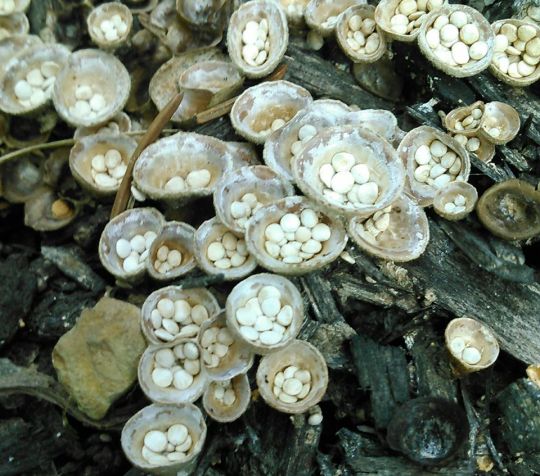
Common Bird’s Nest Fungus (Crucibulum leave)
Measuring just 4-10mm across, these infinitesimal “nests” look as though they have been built by itsy-bitsy birds. The spore-containing “eggs,” called peridoles, are kinetically dispersed by raindrops. These little mushrooms can be found growing on woody debris and even in your mulch bed! You just need to look closely.
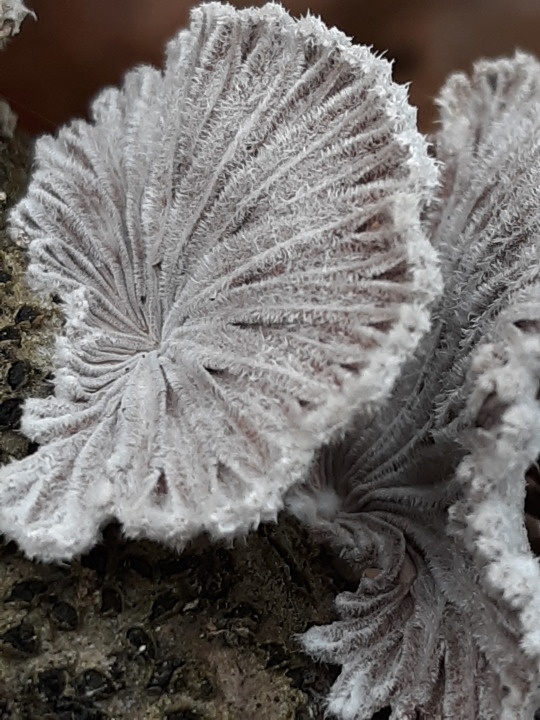
Splitgill Mushroom (Schizophyllum commune)
Spiltgill mushrooms are among the most widely distributed fungi. Beneath their plain caps lies a delicate fan containing basidiospores. These mushrooms have the unique ability to open and close their gills based on moisture levels. When the mushroom dries out, the gills split; hence the name. Look for this hidden beauty on fallen twigs and branches during your next hike.

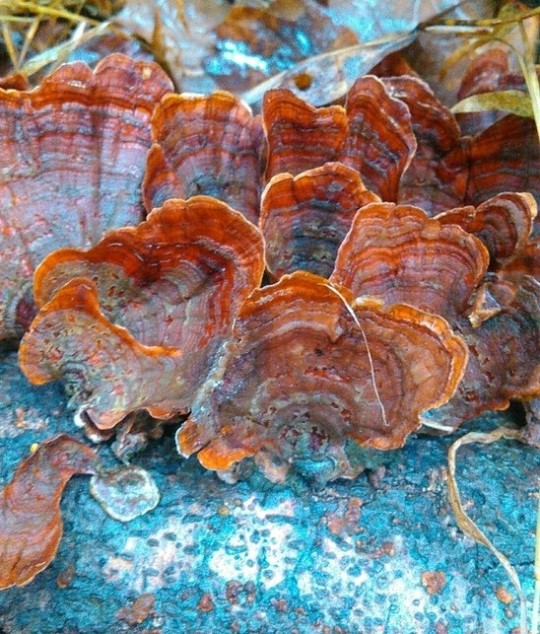

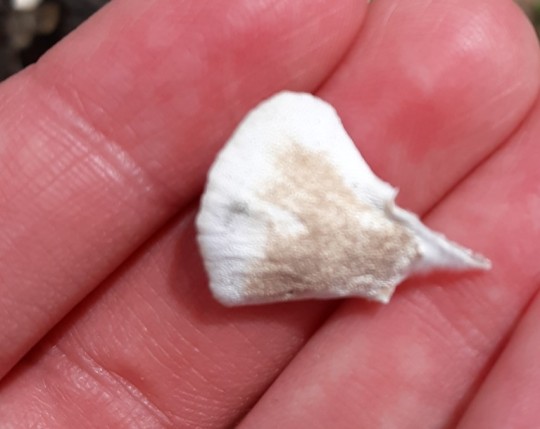
False Turkey-Tail (Stereum sp.) & Turkey-tail (Trametes sp.)
For starters, they look like a turkey’s tail! These seemingly ever-present fungi can be found growing on decaying hardwoods. False turkey-tail, with concentric rings that display deep hues of orange, red, or sometimes white, is often eye-catching. It is called “false” turkey-tail because of its similarity to another group of fungi colloquially called turkey-tail (Trametes sp.). One difference is that Trametes is a polypore (pores on the underside) and Stereum is a crust (smooth on the underside).
Sara Klingensmith is an Environmental Educator and Naturalist at Carnegie Museum of Natural History’s Powdermill Nature Reserve. Museum staff, volunteers, and interns are encouraged to blog about their unique experiences and knowledge gained from working at the museum.
65 notes
·
View notes
Text
ENVS*3000 Blog Prompt 9
Hello all!
After much thought and debate over all of the amazing parts of nature, I finally narrowed my enthusiasm to one blog topic! Today I will be talking about a type of fungus called rusts, and, more specifically, a species of rust commonly known as white pine blister rust (WPBR)). WPBR, or Ronartium ribicola, is a fungus that is native to Asia, and is thought to have migrated to Ontario in 1914 (1). All five needle pines are susceptible to WPBR, though it has had the largest impact in Ontario on Pinus strobus, or white pine (1). The damage caused by WPBR is identified by it’s symptoms, such as small yellow or orange spots on needles, cankers and bulges on twigs, branches, and stems, gummosis ( the leaking of resin/gum from the tree), flagging (death of twigs and branches, resulting in discolored portions of foliage), and tree death (2). WPBR has a high mortality rate in its pine host, and the disease progresses slowly over a number of years (2).
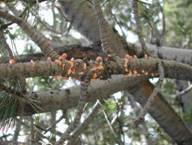
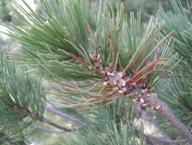
*photos from https://www.fs.fed.us/rm/highelevationwhitepines/Threats/blister-rust-threat.htm *full citation below (2)*
Rust fungi, within the class Pucciniales, have multiple stages of their life cycle, and often require multiple hosts in order to complete their sexual and asexual reproductive cycles (3). The stages of WPBR are: spermogonia (stationary) and spermatia (mobile), which sexually reproduce with each other, aecia (the stationary product of the sexual reproduction) and the aeciospores (mobile) that it releases, the aeciospores cannot reinfect pine, and instead infect their alternate host, Ribes, which then form uredinia, which release more Ribes-infecting urediniospores, until telia and teliospores are produced in the fall, which germinate to produce basidium and basidiospore, which are the only Ribes produced stage that can infect Pinus. If we wanted to break this cycle down more simply it can be said that WPBR will infect Ribes through Pinus originating aeciospores, Ribes is susceptible to be continuously re-infecting through asexual urediniospores, and once a season Pinus is susceptible to infection by basidiospores, from the Ribes host.

*photo from https://www.fs.fed.us/rm/highelevationwhitepines/Threats/blister-rust-threat.htm*
The have been many attempts to contain this fungus, including the local eradication of Ribes species near susceptible Pinus habitats, pruning off infected areas from Pinus trees, pruning to raise Pinus canopies, as evidence suggests that the lower canopy is most commonly affected, and the development of resistance (4).
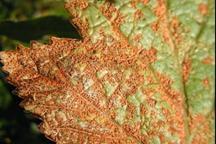
*photo from https://www.fs.fed.us/rm/highelevationwhitepines/Threats/blister-rust-threat.htm*
The complicated life cycle I described above is exactly why I LOVE rusts! With only one host capable of facilitating their sexual reproduction, and the alternate host required to accept it for the new genetic material to survive, it is amazing how effective they are (4)! I am still learning how to communicate complicated and detailed information to the general public, which is a skill stressed by our text, Interpreting Cultural and Natural Heritage for a Better World, in multiple chapters and for many reasons. I think that the most important reason I would like to develop this skill is because plants and fungus are very misunderstood by the general population, so if we can inspire interest in correcting misconceptions (5). For instance, I regularly encounter people who think that if they see fungus on a tree near their house that it is not safe and should be cut down. This is why urban areas are losing trees to rapidly. If people had the passion or interest needed to take the effort to research the fungus on their trees, they might realize that they do not pose a threat (5). Alternatively, they would be able to spot a hazard early enough that we might be able to prune out infected areas and save the whole tree from decay!
Finally, my questions for you are; if you could instill passion in the general public on one natural topic, what would it be and why? Also, if you have ANY questions about my post or rusts/fungus/trees please ask away, I’d love an opportunity to improve my ability to explain it!
Thanks for reading!
Katie the Treehugger
1) Ministry of Natural Resources and Forestry. (2014, July 18). White pine blister rust. Retrieved March 17, 2021, from https://www.ontario.ca/page/white-pine-blister-rust
2) White pine blister Rust and its threat to to high elevation White Pines. (n.d.). Retrieved March 19, 2021, from https://www.fs.fed.us/rm/highelevationwhitepines/Threats/blister-rust-threat.htm
3) Natural Resources Canada Government of Canada. (2015, July 24). White pine blister rust. Retrieved March 18, 2021, from https://tidcf.nrcan.gc.ca/en/diseases/factsheet/24
4) Forest Pathology. (n.d.). White pine blister rust. Retrieved March 17, 2021, from https://forestpathology.org/rusts/white-pine-blister-rust/
5) Beck, L., Cable, T. T., & Knudson, D. M. (2019). Chapter 5: Guiding Principles of Interpretation. In Interpreting cultural and natural heritage: For a better world (pp. 81-101). Urbana: Sagamore Publishing.
2 notes
·
View notes
Text
stay (amos/prax)
An AU in which Amos asks Prax to continue on the Roci.
Note: I wrote this for a friend. I have not seen the show nor have I read the books. I read a couple short fanfics as well as some wiki articles and a review of the episode “Immolation.” This has not been beta’d yet.
-------------------------------------------------------------
Amos didn't fear like other people did. Battles were just another task to complete. Killing, when it was needed, wasn't anything special. He thought he'd left his fear behind in Baltimore, but then he watched Prax embrace his little girl and he knew. This was something he could not lose. Not that it was something he technically had, but things didn't have to make sense to be true. He suddenly understood his motivations for teaching the doc how to handle a gun better than he had before.
(Later the doc will tell him thank you and in some universes Amos says nothing or blows it off or takes the thanks awkwardly but in this universe, with a sigh like he cannot believe the words are coming out of his own mouth, he says, "You should stay on the Roci."
"It isn't safe," Prax protests.
"No where is, Doc. Least here we can keep a watch out."
"People need me on Ganymede."
"You're not the only botanist. You're good, but they'll get by without you."
"The Roci doesn't need me either," Prax says gently, and he isn't wrong, but that strange, tight sensation Amos felt watching Prax and his daughter reunite has not faded. Amos is still focused and calm, but he knows that this is fear like he hasn't felt in years.
"Maybe," he concedes, and Prax is about to say something and pull away, so he adds, "You're my best friend."
And Prax stays.)
Mei took to the ship with the ease of a cat. Amos appreciated that she didn't let what happened to her rule her. Maybe it wasn't healthy, but he respected it. She sat down across from him as he took apart and cleaned his weapons. Her father sat at the head of the table trading messages back and forth with the farmers back on Ganymede.
"You kill people," Mei said.
"I have."
"You killed Dr. Strickland."
He raised his brows wondering how she'd figured that tidbit out. "I did."
She nodded. "Good." In the corner of his eye, Amos noticed the doc had a smile curled in his cheek. He was about to call it out when Mei spoke again. "Did you use those?"
He took a second to parse the question and shook his head. "No."
"Oh." She sounded disappointed. "Can you teach me?"
Prax was not pretending to read now. Amos glanced his way, but the doc gave no hint on what he should say. "When you're older," he decided. He wouldn't always be there to shoot her monsters.
Mei tilted her head. "How much older?"
He didn't laugh, but it was a near thing. "I'll have to talk it over with your dad."
("Why didn't you step in," he'll ask Prax later. "Seems like the sort of thing a parent should be discussing with their kid."
"I trust you," Prax will reply, like it's that simple.)
"What are we looking for again?"
"A fan-shaped fungus. It will likely be growing in groups on the sides of trees, if its Earth counterparts are any guide. Amateur reports suggest this ganoderma-like species is especially effective for bioremediation, making it potentially very valuable for my work on Ganymede and," he paused, looking around the alien forest, "anywhere, really." He smiled back at Amos. "Thanks for helping me convince Holden."
Amos shrugged. "We're in a lull."
"Even so," Prax said, with an increasingly familiar, knowing smile, "Thank you."
"I don't like being idle." He scanned their surroundings, the strange fear taking hold again, and nearly sighed aloud in relief when he noticed mushrooms growing like disconnected stairs on a tree. "That your fungus?" he asked, gesturing.
Prax turned to look. "Oh," he said, brightly. "I believe it is."
(Amos will linger in the lab Prax has claimed as his own, filling it with equipment and materials essential for whatever research he is doing.
He'll watch as the doc does his thing and shines with a quiet competence Amos doesn't fully understand, but certainly appreciates. Prax monologues as he works and Amos lets the words wash over him, soothing like a hot shower is.
"Here, look," Prax interrupts, gesturing Amos over to look through a microscope. "Do you see where I've sliced it? The thin outer layer and thicker inner one? This is one of the basidiospore. That double wall suggests that this species does indeed belong to the ganoderma genus."
Amos looks but sees none of that. All of his focus is on the soft hush of the doc's voice at his ear and the warmth of his hand on his back. "So you're good then," he asks, stepping away and striving to regain control of himself and the situation.
"It is only one indicator,” Prax says, watching him with a thoughtful tilt to his head. “Suggestive, but inconclusive." The silence stretches; his mouth is dry. Prax shakes his head. "This isn't that exciting, I suppose. I must be boring you."
"You're not. You couldn't." He doesn't mean to add that second reassurance. It feels too exposing, but it makes Prax smile so he doesn't take it back.)
Mei found him in a corridor. She was in pajama, her braids messy from sleep. The doc had put her to bed only a couple hours ago; she shouldn't be awake. "Carry me?" she asked.
Amos picked her up without reply. She nestled under his chin and yawned. "Can we find Daddy?"
He turned toward the labs, reasoning she'd have found her dad by now if he was in their quarters. "Why are you awake?"
"Bad dreams," she said with a resigned tone too weighted for a five year old.
Prax stepped into the corridor with a tablet. He glanced up and his eyes widened. "Mei, are you all right?"
She shook her head; her hair tickled under Amos' jaw. "I was scared, but I found Amos. He killed the doctor. And then we found you. So I'm okay now."
"Why don't we go back to bed?" Prax said, stepping closer. He rubbed his hand over Mei's back and shoulder. "I'll stay with you this time."
"Amos too?" Mei asked. "He has guns, Daddy."
Prax glanced up at him and tilted his head questioningly.
"Amos, too," Amos agreed and Mei hummed. He turned and walked back to the doc's quarters. Prax remained close, squeezing Mei's dangling feet as he walked. His shoulder kept brushing Amos' arm, but he didn't move away.
When they reached the rooms, Prax directed Amos to his bedroom instead of Mei's. "She likes to sleep with me after a nightmare," he explained. Amos gently laid the girl on the bed; she was already fast asleep.
"Looks like she's good. I'll get out of your hair." He stepped back, but Prax reached out and touched his elbow and Amos stilled.
"Or you could stay," Prax said softly. The light touch of his fingers became the warm hold of his hand around the back of his elbow. He watched Amos for a long moment and Amos felt little but the tight fear in his belly and the desperate, dueling needs to both flee and remain exactly where he was. Prax leaned in and gently pressed his lips to Amos'. "It doesn't have to be anything, but I like you. You make Mei feel safe. You're my best friend. If this is too much--" he didn't finish the sentence, but his hand did drop away.
Amos looked at him and at Mei sleeping in his bed. The tightening in his stomach wasn’t fear, he realized; it was want. "What do you want?"
"What I've always wanted," Prax said with a self-conscious shrug. "My family." He was looking at Amos.
Amos swallowed. "I'll stay."
(He teaches Mei to fire a gun. And he kisses way down Prax against the door of his lab until the doc agrees to take a damn break. He moves his belongings slowly to Prax's rooms. He takes turns telling Mei bedtime stories. He tells Prax about his childhood. Mei curls in his lap after another nightmare. When they run low on medication for Mei, he sits in silence with Prax for as long as he needs. And Mei gifts him one of her lost teeth. And Prax pins him against the bed with a knowing smirk. And they stay, the three of them, together).
1 note
·
View note
Photo
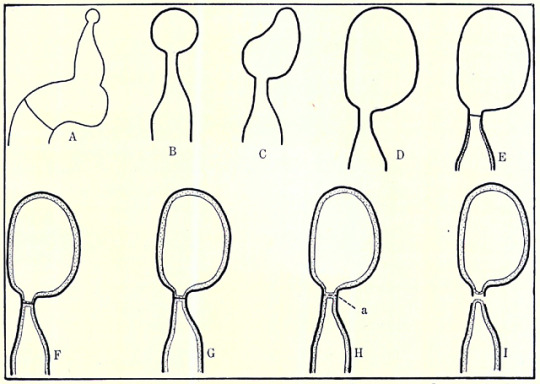
“Semidiagrammatic representation of basidiospore development and dis- charge..” Farlowia, a journal of cryptogamic botany. v.1. 1943.
Internet Archive
43 notes
·
View notes
Photo
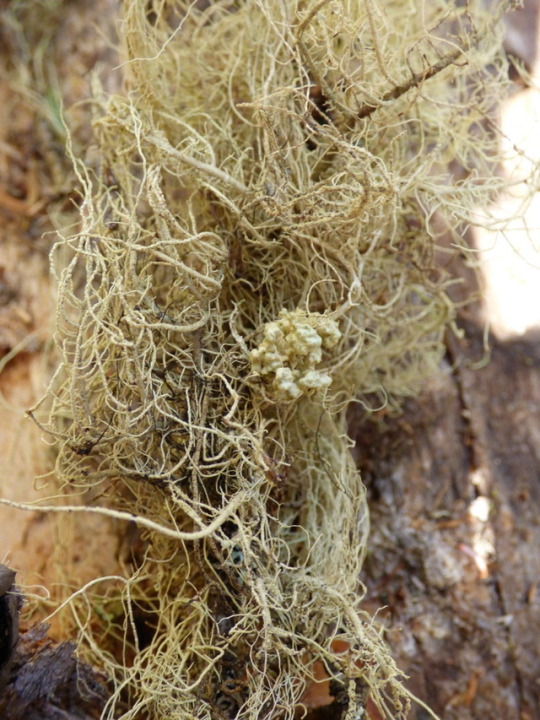
Preface
Yes, this post is long enough to require a preface.
As promised, this is the extent of the world’s knowledge on Tremella everniae, gathered from the literature and an interview with Veera Tuovinen, a grad student who does research on this species. This was originally written as an assignment for my Fungi course where I had to make a wikipedia-style page about a species, and now I’m sharing it with y’all to celebrate getting an A+ in the course AND a job working with my prof this summer!
Tremella everniae
Binomial name: Tremella everniae Deiderich
English name: none
Classification
Phylum: Basidiomycota
Class: Tremellomycetes
Order: Tremellales
Family: Tremellaceae
Genus: Tremella
Species: Tremella everniae
Description
Tremella everniae is a lichenicolous Basidiomycete fungus thought to be parasitic on the Ascomycete lichens Evernia mesomorpha, Evernia prunastri, and Evernia esorediosa. The only structure currently described is its fruiting body or basidioma, which is a popcorn-like gall formed on the host. The basidioma is 3-15mm in diameter and is initially the same grey-green colour as the host, then develops a brownish hymenium at maturity. The interior of the basidioma appears white and fluffy, and contains hyphae of both T. everniae and the host fungus, algal cells, and basidia and basidiospores of T. everniae.
Tremella everniae is a heterobasidiomycete. Heterobasidiomycetes are a polyphyletic group characterized by basidiospores which can germinate by means of secondary spores, basidia that are are often septate, and being saprophytes or parasites on other fungi or on plants. The genus Tremella is not a monophyletic group, so T. everniae has little in common with jelly fungi also included in this genus.
Life Cycle
Tremella species are generally all dimorphic, having a hyphal teleomorph and a yeast anamorph. Although only the fruiting body of the hyphal phase has been described in T. everniae, it is assumed that this species is dimorphic and has a yeast phase as well. It is hypothesized that the yeast phase may be found in the cortex of the host lichen.
There are two phases of the dimorphic life cycle, haploid yeast and dikaryotic mycelium. The yeast cells conjugate to form the mycelium, which then forms the fruiting body, which produces basidiospores that give rise to more yeast cells. The mycelium may also produce conidia which give rise to yeast cells.
Ecology and Distribution
Tremella everniae can be found on the lichen Evernia mesomorpha. It has also been found on the lichens Evernia prunastri in Europe and Evernia esorediosa in northern Asia.
The exact distribution of T. everniae is unknown but assumed to be the same as that of its host lichens. E. mesomorpha is found over conifers in open boreal forests at lower elevations. E. prunastri is found over coniferous and deciduous trees and shrubs in sheltered, humid forests at lower elevations. Both host lichens are incompletely circumpolar.
In Alberta, T. everniae can be found in the boreal forest.
Parasitism
Tremella everniae is thought to be mycoparasitic on the fungus in its host lichens. Almost all Tremella species are mycoparasites, and so it is assumed that the same is true of T. everniae. However, because the genus Tremella is polyphyletic, its species may bear little resemblance to each other. T. everniae has lots of haustoria, the structures known to be used by parasitic fungi to extract resources from their hosts, however the presence of haustoria is not necessarily evidence of mycoparasitism. It is unknown whether the haustoria of T. everniae actually penetrate the host cells. Additionally, some assume that the presence of galls is automatically an indication of disease, however this has not been proven.
Future Research
Very little is known about Tremella everniae! Future research could focus on locating the yeast phase, and determining the exact nature of the relationship between T. everniae and its host lichen. It would also be valuable to determine the phylogenetic relationships within the polyphyletic genus Tremella in order to make valid comparisons between species.
Gallery
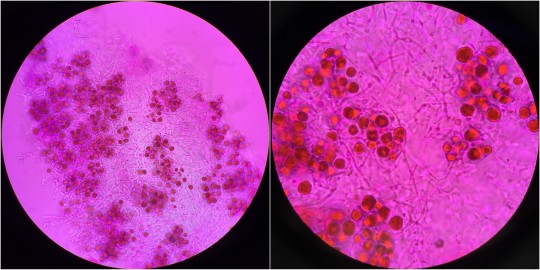
Left: Cross section of Tremella everniae fruiting body stained with phloxine and viewed at 40x magnification. Note the algal cells (large red circles) and fungal hyphae (squiggly lines). Right: Cross section of Tremella everniae fruiting body stained with phloxine and viewed at 100x magnification.
References
von Brackel, W. and D. Puntillo. 2016. New records of lichenicolous fungi from Calabria (southern Italy), including a first checklist. Herzogia 29(2):277-306.
Diederich, P. The Lichenicolous Heterobasidiomycetes. Bibliotheca Lichenologica 61.
Goward, T. 1999. The Lichens of British Columbia: Illustrated Keys, Part 2 - Fruticose Species. Crown Publications, Victoria, British Columbia, Canada.
Liu, X.-Z., Q.-M. Wang, M. Göker, M. Groenewald, A. V. Kachalkin, H. T. Lumbsch, A. M. Millanes, M. Wedin, A. M. Yurkov, T. Boekhout, and F.-Y. Bai. 2016. Towards an integrated phylogenetic classification of the Tremellomycetes. Studies in Mycology 81:85-147.
Millanes, A. M., P. Diederich, S. Ekman, and M. Wedin. 2011. Phylogeny and character evolution in the jelly fungi (Tremellomycetes, Basidiomycota, Fungi). Molecular Phylogenetics and Evolution 61:12-28.
Zhurbenko, M. P. and S. E. Vershinina. 2014. Opegrapha bryoriae sp. nov. and other lichenicolous fungi from Asian Russia. Herzogia 27(1):93-109.
Zugmaier, W., R. Bauer, and F. Oberwinkler. 1994. Mycoparasitism of some Tremella species. Mycologia 86(1):49-56.
#fungi#fungus#lichen#lichens#mycology#science#tremella#tremella everniae#evernia#evernia mesomorpha#evernia prunastri#evernia esorediosa#lichenicolous fungus#mycoparasitism#lichenology#not plants
29 notes
·
View notes
Text
Vocabulary (pt.mlxxxiv)
Words taken from Mushrooms of the Northeastern United States and Eastern Canada by Timothy J. Baroni:
contact dermatitis (n.)
inflammation of the skin caused by direct contact with an irritant (irritant contact dermatitis) or allergen (allergic contact dermatitis). [x]
endotrophic (adj.)
penetrating into the associated root and ramifying between the cells. [x]
perithecium (n.)
a spherical, cylindrical, or flask-shaped hollow fruiting body in various ascomycetous fungi that contains the asci and usually opens by a terminal pore. [x]
psychoactive (adj.)
(especially of a drug) affecting the mind.
substrate (n.)
geology. a layer of soil, earth, clay, or rock beneath the surface. biology. the surface or material on which any particular organism grows.
basidiospore (n.)
a spore produced by a basidium. [x]
basidium (pl. basidia) (n.)
a microscopic spore-bearing structure produced by certain fungi.
aqueous (adj.)
of, containing, or like water.
mycophagist (n.)
one that eats fungi (such as mushrooms). [x]
sordid (adj.)
immoral, base, degenerate.
#av#avdictionary#vocabulary#Mushrooms of the Northeastern United States and Eastern Canada#Timothy J. Baroni
0 notes
Text
Mushroom are the fleshy fungi which constitute a major group of lower kingdom . The mushroom is a common fungal fruit body that produces basidiospores at the tip of clublike structure, called basidia, which are arrenged along the gills of the mushroom . Beneath the mushroom , in the soil, is the mold colony itself , consisting of mat of intertwined hyphae, sometimes several feet in diameter .the mushroom First appear as white tiny balls cosisting of short stem and a cap . Which begin to open up like an umbrella. The delicate membrane or veil to envelope the cap tears off, if allowed to develop fully,and lamella radiaing from the stalk into ,the cap become visible. These gills become darkened as the basiospoers develop into million and fall to the ground for starting their lifecycle once again for second generation of mushroom . Since mushroom grown independent of sunlight so they can be grown in complete darkness but the darkness is not essential prerequisite. They are relatively fast growing , do not require fretile soil , science grown on composted or uncomposted agro- wastes, and their culture can be concentrated within a relatively small space . In addition to floor , air space is also utilized resulting in higher production . It is a labour intensive indoor activity which can help the landless ,small and marginal farmers to raise their income diversify economic activity and can create gainful employment especially for unemployed youths, weaker section of the society and women folk .
It produces nutritious food from unused resources , available surplus in India and also can earn foreign exchange.Mushroom are the fleshy fungi which constitute a major group of lower kingdom . The mushroom is a common fungal fruit body that produces basidiospores at the tip of clublike structure, called basidia, which are arrenged along the gills of the mushroom . Beneath the mushroom , in the soil, is the mold colony itself , consisting of mat of intertwined hyphae, sometimes several feet in diameter .the mushroom First appear as white tiny balls cosisting of short stem and a cap . Which begin to open up like an umbrella. The delicate membrane or veil to envelope the cap tears off, if allowed to develop fully,and lamella radiaing from the stalk into ,the cap become visible. These gills become darkened as the basiospoers develop into million and fall to the ground for starting their lifecycle once again for second generation of mushroom . Since mushroom grown independent of sunlight so they can be grown in complete darkness but the darkness is not essential prerequisite. They are relatively fast growing , do not require fretile soil , science grown on composted or uncomposted agro- wastes, and their culture can be concentrated within a relatively small space . In addition to floor , air space is also utilized resulting in higher production . It is a labour intensive indoor activity which can help the landless ,small and marginal farmers to raise their income diversify economic activity and can create gainful employment especially for unemployed youths, weaker section of the society and women folk .
It produces nutritious food from unused resources , available surplus in India and also can earn foreign exchange.https://scienceequation10.blogspot.com/?m=1
1 note
·
View note